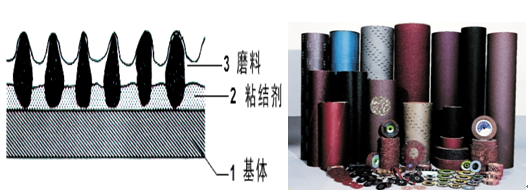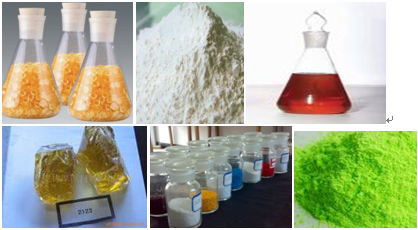
I. Overview of Coated Abrasive Tools
Grinding materials and grinding tools are known as the teeth of industry, and coated abrasive tools are honored as industrial beautician. In most domestic books and textbooks, coated abrasive tools are defined as tools that can be used to grind and polish by binding abrasives onto flexible materials such as cloth and paper, which are also called flexible abrasives in the industry. The classification includes roll, sheet, strip, disc and special-shaped products made of cloth, paper and non-woven fabrics; polishing products made of cotton, hemp and wool as well as solid and liquid abrasives are also included. The main varieties are abrasive cloth (paper) and abrasive belt, which are often used in mechanical or manual operation. They are widely used for grinding, buffing and polishing of metal materials, wood, ceramics, plastics, leather, rubber and paint putty. Coated abrasive tools are composed of three parts: the matrix, abrasives and binders, and they are also called three elements.

1. The matrix
It is the bearing body of abrasives and binders and the dominant factor for the flexibility of abrasive belt.
The matrix of coated abrasive tools mainly includes paper, cloth, steel paper, composite matrix, non-woven fabric, polyester film and so on. Before manufacturing abrasive tools, the matrix must be specially treated. The performance of the matrix is related to its own type and the treatment method.
The matrix treatment is to improve and promote the physical and mechanical properties of the matrix through the matrix treatment agent as well as meet the needs of rubber coating, abrasive grain dispensing and grinding.
The general matrix treatment can be divided into two categories: non-water resistant treatment and water resistant treatment. According to different grinding conditions, the matrix can also be treated with softening treatment, high permeability resistance treatment, oil resistance treatment and electrostatic treatment. Specific classification of matrix:
2. Abrasives
Abrasive is a kind of granular material with high hardness and certain mechanical strength, which is used to manufacture abrasive tools or directly used for grinding and polishing. Abrasives can be divided into natural abrasives and artificial abrasives.
Abrasives must have some basic properties: a certain hardness, a certain strength, appropriate crumbliness and self-sharpening, a certain physical and chemical stability or thermal stability.
3. Binders
The binder plays the role of bonding the abrasive and the matrix, so that the abrasive tools have a certain shape and strength. The binders in coated abrasive tools are generally composed of base material treatment agent, primer and compound glue.

(1) Base material treatment agent: It is mainly used to improve the physical and mechanical properties of the base material, ensure the good quality of rubber coating and abrasive grain dispensing, and give the product good service performance. According to the different use requirements of products, the base material treatment can be divided into non-water resistant treatment and water resistant treatment, and the base material treatment agent should be suitable for it.
(2) Primer: It is the coating that is used to adhere the abrasive to the base material, which plays the role of bonding and fixing the abrasive.
(3) Compound glue: It is used to coat another layer of binder on the fixed abrasive grains to surround the abrasives, so as to further strengthen the bond strength between the abrasive particles and the basic material, and ensure that the abrasive grains can withstand the extrusion and impact of grinding force without falling off easily during grinding.
II. Common Types of Coated Abrasive Tools
1. Brown aluminium oxide (A,WA): The main component is α - AI2O3. It has brown or reddish brown appearance, high hardness, good toughness and is able to bear great pressure. With high temperature resistance, corrosion resistance, good chemical stability and other characteristics, it is widely used in industry. It is suitable for grinding metal materials with high tensile strength such as ordinary carbon steel, hard bronze, alloy steel and malleable cast iron.
2. White corundum (A, WA): The main component is α - AI2O3, and it is white. The hardness is higher than brown aluminium oxide, and the toughness is lower than brown aluminium oxide. White corundum is brittle, so the abrasive is easy to break, but it has good sharpness. It is mainly used for fine grinding and accurate grinding of hardened steel and alloy steel as well as thread and gear grinding. It can also be used for precision castings and high-duty refractories.
3. Silicon carbide (C, GC): Silicon carbide includes black silicon carbide and green silicon carbide. The main component is SiC. It is black and brittle, and has the characteristics of high hardness and good sharpness. SiC does not react with any acid substance, but the melt of basic oxide can promote its decomposition. Compared with corundum, black silicon carbide has higher hardness and brittleness, which is not only suitable for processing metal or nonmetal with low tensile strength such as gray cast iron, brass, lead, aluminum and other non-ferrous metals, but also for non-metallic stearic brittle materials such as glass and ceramics.
4. Green silicon carbide has higher purity, hardness and brittleness than black silicon carbide, which is suitable for processing hard and brittle materials such as cemented carbide, glass and agate. It is also widely used in measuring tools, cutting tools, accurate grinding of molds and various cylinder grinding.
5. Fused alumina zirconia (ZA): The main component is the eutecticum of α - AI2O3 and AI2O3 Zr. It appears gray white or gray brown and has good toughness and wear resistance. ZA is suitable for high-speed heavy load grinding and the processing of the metal materials that are hard to grind. For example, it is suitable for grinding cast steel, alloy steel, high-speed steel, and especially suitable for titanium alloy, heat-resistant alloy, high-vanadium steel and stainless steel.
III. Classification of Coated Abrasive Tools
According to different base materials, abrasives and binders, coated abrasive tools can be divided into many varieties with different properties and uses. According to different types of coated abrasives, they can be divided into the following types:
1. According to the base materials and use methods, coated abrasive tools are divided into dry abrasive cloth, waterproof abrasive cloth, dry abrasive paper, waterproof sandpaper, etc.
2. According to the binders and base material treatment, coated abrasive tools are divided into animal glue bonded abrasive tools, resin bonded coated abrasive tools, resin over resin bonded coated abrasive tools and water-resistant coated abrasive tools.
3. According to the abrasive materials and particle sizes: abrasive material represents the type and performance of the abrasive, and abrasive particle size represents the size and distribution of abrasive particles. Different abrasive materials and particle sizes can be divided into different coated abrasive tools. In addition, there are also codes for dry abrasive cloth (BG) and waterproof sandpaper (Zn), which are used in the market for different particle sizes.
4. According to the density of abrasive grain dispensing: It refers to the density of abrasive particles on the surface of coated abrasive tools. The abrasive grain dispensing density of coated abrasive tools can be divided into dense abrasive grain dispensing (CL) with the density of 100% and sparse abrasive grain dispensing (OP) with the density of 50% - 70%.
5. According to product shapes, coated abrasive tools can be divided into sheet (y), roll (J), ribbon (d), disc (P) and abnormal shape (T).
According to the usage and circulation, the classification according to binders and base material treatment is more reasonable, and combined with the classification according to product shapes, the requirements can be basically satisfied.
IV. Applications of Coated Abrasive Tools
The grinding of coated abrasive tools is characterized by elastic and high-efficiency cold machining, and they are widely used in the following fields:
1. The processing of large thick or thin flat plates, including metal strip processing; YD
2. The processing of various metal and non-metallic workpieces produced in large quantities; YDP
3. The molding, grinding and polishing of workpiece with complex profile; YT
4. External cylindrical grinding, curved surface grinding and internal grinding of metal pipes, bars and rollers of various diameters.PY
5. It can replace polishing wheels by using flap wheels or cylinder abrasive sleeves; LT
6. Disc products are used for grinding welds, deburring and large-area derusting of large shells, boxes, ship hulls and bridges, which is efficient, convenient and safe.